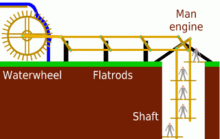Man engine
A man engine is a mechanism of reciprocating ladders and stationary platforms installed in mines to assist the miners' journeys to and from the working levels.
[1] The steam engine or water wheel would be linked to a series of beams – known as "rods" – fastened together and reaching to the bottom of the mineshaft.
The moving platforms were often small, typically 12 inches (30 centimetres) square, to make the miner stand close to the centre-line of the rod and thus keep a safe distance from the sides of the shaft.
Miners could ascend and descend at the same time: the pause at the changeover point was made long enough (typically between two and eight seconds)[4] for two men to change places.
[5] Counterweights – large boxes filled with stones attached through "see-sawing" horizontal beams – were installed to avoid the full weight of the shaft and men bearing on the top linkage.
In the deepest mines, which could sink to more than 350 fathoms (640 metres), extra counterweights were provided at regular intervals, in horizontal side galleries.
[1] When cable operated winding gear became available the man engines continued in use, particularly in cases where the mineshaft was not truly vertical and winding engines drawing suspended cages could not be used; with the provision of a few well-placed rollers, and “fend offs” mounted on trunnions, the rods could reach the bottom of a shaft even at a substantial deviation from the vertical.
[15][16] In some mines, particularly in Germany, wedges or collars placed just above close-fitting rollers, or chains, were installed to limit any drop should a breakage occur.
The topmost safety cross-piece attached to the rod, which should have caught on a fixed ledge (the "sill") in case of its dropping too far, fell out of alignment because of the breakage and failed to engage.




